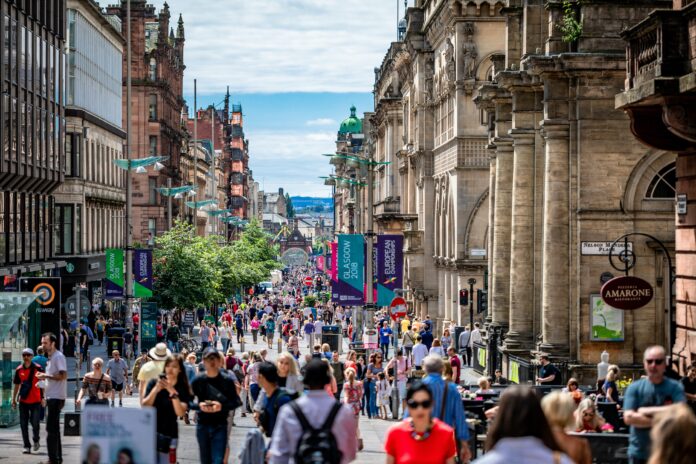On October 15, the world’s first UNESCO National Trail was launched in Scotland. The digital Trail connects 13 UNESCO heritage sites across the country, and aims to enhance the economic and social well-being of their respective local areas through sustainable tourism. Every stop on the Trail highlights a different social or cultural theme. From Glasgow’s city of music to the prehistoric monuments of Orkney, the UNESCO Trail offers beauty, history, education and sustainability.
UNRIC spoke to Anne Anderson, a proud Scot and Vice Chair of the UK National Commission for UNESCO, about the project.
How did you become involved in the Trail?
I am the Vice Chair of the UK National Commission for UNESCO an unpaid role appointed by the Foreign Secretary. My predecessor Dr Beth Taylor who was UK National Commission Chair, and like me a proud Scot, had lobbied for this project as a way of showcasing Scotland’s fabulous range of UNESCO designations. My role in the process was to work on the Steering Group with the 13 UNESCO designations and VisitScotland to identify what we all wanted to achieve with the trail in terms of UNESCO’s values and the needs of the designations and their host communities. This work was underway when the pandemic struck and everything had to be halted while the designations dealt with the devastating impacts of lockdown on every aspect of their income and activities.
Tell us about your role and the challenges along the way
I am so proud of having had a role in reactivating the project as we started to emerge from the most stringent period of lockdown. I approached our VisitScotland colleagues to encourage them to liaise with the Scottish Government to allow the funds to be restored and for the work of the Trail to recommence as the need to rebuild the cultural and visitor economy was extremely pressing. It was also very timely in that we were already planning this as a sustainable and responsible tourism initiative which was well aligned with the aims of a greener recovery from the pandemic.
The biggest challenge was bourne by the designations who had to keep engaged with the project and the many calls on them for input and engagement at what was the most difficult period any of us had ever experienced. I am very proud of the way all the designations did this even when staff were working from home or furloughed and when the future seemed so uncertain. It was critically important that everyone felt a sense of ownership of the Trail and that the materials and resources that were being developed were true to the UNESCO values of their designations.
Why is the Trail so important?
What I love about the trail is that it highlights the variety of Scotland’s UNESCO designations across the whole country from north to south. People tend to have heard of UNESCO World Heritage sites and we of course have some fabulous WH sites from Neolithic Orkney to the Antonine Wall and New Lanark. But fewer people are aware of our UNESCO Creative Cities, My home Glasgow as a City of Music, Dundee as a City of Design and Edinburgh as the world’s first UNESCO city of Literature. Similarly GeoParks and Biospheres are incredibly important but less well known so it is great to highlight where these are from the far north in Shetland’s GeoPark trite down to the border and Galloway and South Ayrshire Biosphere.
The trail’s value as a digital asset is twofold. Firstly it provides an enduring resource that will provide a means of showcasing Scotland’s wonders to local communities and potential visitors alike. It is also a way of informing people wherever they are about UNESCO and our designations even if they never physically come to Scotland.
How does the Trail engage the public in sustainable tourism?
Communities which host UNESCO designations take great pride in their local treasure but financial resources are needed to sustain and develop these wonderful assets. Our aim is for the Trail to provide a way of encouraging people to learn about the designations and to visit and experience them in a way that is meaningful for the visitor and is responsible and sustainable for the designation and the surrounding community. So for example, we are providing information which allows visitors to choose greener travel options, we are encouraging visitors to think about the most suitable time of year to visit, all the local businesses which are referenced in the trail are part of green accreditation schemes. We hope that the Scotland UNESCO trail will be a prime example of responsible tourism.
How is the Trail connected to the SDGs?
All of the UNESCO designations contribute to one or more of the SDGs. All play a role in education with locals and visitors. Many are providing explicit protection to key cultural and natural heritage assets.
UNESCO designations around the world highlight what is finest in our shared cultural heritage and environment. By showcasing the treasures we have in Scotland and encouraging meaningful interactions between locals and visitors around these very special places I believe we are fostering exactly the kinds of dialogue and understanding that motivated the founding of UNESCO in London in the aftermath of WW2.
What is the impact on COP26?
We plan a number of activities around COP26, which of course is being hosted in one of our Trail sites, Glasgow UNESCO City of Music. One of the events will bring together key UNESCO experts on Sustainable Tourism with policy makers, academics and students who are involved in research and education around tourism, to publicize the UNESCO Trail and responsible tourism more broadly. We hope that the focus that COPS 26 will provide on the need to cherish the environment, will mean that the message of the Scotland UNESCO Trail will resonate both with locals and potential visitors.



